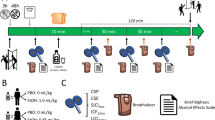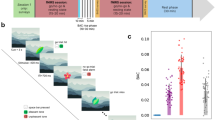Abstract
Rationale
Functional magnetic resonance imaging (fMRI) studies involving alcohol challenge are important for identifying neural correlates of alcohol’s psychopharmacological effects. However, evaluating acute alcohol effects on blood oxygen level-dependent (BOLD) signal change is complicated by alcohol-related increases in cerebral blood flow (CBF).
Objectives
The present study aimed to further characterize acute alcohol effects on CBF using intravenous alcohol administration to maximize control over brain alcohol exposure.
Methods
Twenty heavy-drinking young adults (M = 19.95 years old, SD = 0.76) completed alcohol and placebo imaging sessions in a within-subject, counter-balanced, placebo-controlled design. Arterial spin labeling (ASL) provided estimates of perfusion change at two target blood alcohol concentrations (40 and 80 mg%) relative to baseline and relative to a saline control infusion.
Results
Voxel-wise analyses showed widespread and dose-dependent effects of alcohol on CBF increase. Region-of-interest analyses confirmed these findings, also indicating regional variation in the magnitude of perfusion change. Additional findings indicated that lower self-reported sensitivity to alcohol corresponded with reduced perfusion change during alcohol administration.
Conclusions
This study provides further evidence for widespread effects of acute alcohol on cerebral perfusion, also demonstrating regional, dose-dependent, and inter-individual variation. Further research is needed to evaluate implications of these effects for the design and interpretation of pharmacological fMRI studies involving alcohol challenge.




Similar content being viewed by others
Notes
Preliminary analyses also evaluated cigarette smoking as a potential influence on cerebral blood flow (CBF). Baseline (T1) measures of global cerebral blood flow (derived from the placebo session) did not differ between smokers vs. non-smokers (p = 0.91) and were not associated with hours since last cigarette among smokers (p = 0.93). These smoking variables also showed no significant relation to baseline CBF across the regions of interest depicted in Table S2 (see Online Resource), ps > 0.10. Among smokers, number of hours since last cigarette did not differ significantly between alcohol and placebo scans (p = 0.18).
References
Alsop DC, Detre JA (1996) Reduced transit-time sensitivity in noninvasive magnetic resonance imaging of human cerebral blood flow. J Cereb Blood Flow Metab 16:1236–1249. doi:10.1097/00004647-199611000-00019
Anderson BM, Stevens MC, Meda SA et al (2010) Functional imaging of cognitive control during acute alcohol intoxication. Alcohol Clin Exp Res 35:156–165. doi:10.1111/j.1530-0277.2010.01332.x
Bjork JM, Gilman JM (2013) The effects of acute alcohol administration on the human brain: insights from neuroimaging. Neuropharmacology. doi:10.1016/j.neuropharm.2013.07.039
Bühler M, Mann K (2011) Alcohol and the human brain: a systematic review of different neuroimaging methods. Alcohol Clin Exp Res 35:1771–1793. doi:10.1111/j.1530-0277.2011.01540.x
Chen Y, Wang DJ, Detre JA (2011) Test–retest reliability of arterial spin labeling with common labeling strategies. J Magn Reson Imaging 33:940–949. doi:10.1002/jmri.22345
Claus ED, Ramchandani VA, Hendershot CS (2013) Effects of alcohol on canonical and customized hemodynamic response functions. Alcohol Clin Exp Res 37:57A
Dixon WT, Sardashti M, Castillo M, Stomp GP (1991) Multiple inversion recovery reduces static tissue signal in angiograms. Magn Reson Med 18:257–268. doi:10.1002/mrm.1910180202
Gan G, Guevara A, Marxen M et al (2014) Alcohol-induced impairment of inhibitory control is linked to attenuated brain responses in right fronto-temporal cortex. Biol Psychiatry. doi:10.1016/j.biopsych.2013.12.017
Gilman JM, Ramchandani VA, Davis MB et al (2008) Why we like to drink: a functional magnetic resonance imaging study of the rewarding and anxiolytic effects of alcohol. J Neurosci 28:4583–4591. doi:10.1523/JNEUROSCI.0086-08.2008
Gilman JM, Ramchandani VA, Crouss T, Hommer DW (2012) Subjective and neural responses to intravenous alcohol in young adults with light and heavy drinking patterns. Neuropsychopharmacology 37:467–477. doi:10.1038/npp.2011.206
Heatherton TF, Kozlowski LT, Frecker RC, Fagerström KO (1991) The Fagerström test for nicotine dependence: a revision of the Fagerström tolerance questionnaire. Br J Addict 86:1119–1127. doi:10.1111/j.1360-0443.1991.tb01879.x
Järnum H, Steffensen EG, Knutsson L et al (2010) Perfusion MRI of brain tumours: a comparative study of pseudo-continuous arterial spin labelling and dynamic susceptibility contrast imaging. Neuroradiology. doi:10.1007/s00234-009-0616-6
Jenkinson M, Beckmann CF, Behrens TEJ et al (2012) FSL. NeuroImage 62:782–790. doi:10.1016/j.neuroimage.2011.09.015
Kareken DA, Grahame N, Dzemidzic M et al (2011) fMRI of the brain’s response to stimuli experimentally paired with alcohol intoxication. Psychopharmacol (Berl) 220:787–797. doi:10.1007/s00213-011-2526-7
Kareken DA, Dzemidzic M, Wetherill L et al (2013) Family history of alcoholism interacts with alcohol to affect brain regions involved in behavioral inhibition. Psychopharmacol (Berl) 228:335–345. doi:10.1007/s00213-013-3038-4
Khalili-Mahani N, van Osch MJP, Baerends E et al (2011) Pseudocontinuous arterial spin labeling reveals dissociable effects of morphine and alcohol on regional cerebral blood flow. J Cereb Blood Flow Metab 31:1321–1333. doi:10.1038/jcbfm.2010.234
King AC, de Wit H, McNamara PJ et al (2011) Rewarding, stimulant, and sedative alcohol responses and relationship to future binge drinking. Arch Gen Psychiat 68:389–399. doi:10.1001/archgenpsychiatry.2011.26
Lancaster JL, Rainey LH, Summerlin JL et al (1997) Automated labeling of the human brain: a preliminary report on the development and evaluation of a forward-transform method. Hum Brain Mapp 4:238–242. doi:10.1002/(SICI)1097-0193(1997)5:4<238::AID-HBM6>3.0.CO;2-4
Lancaster JL, Woldorff MG, Parsons LM et al (2000) Automated Talairach Atlas labels for functional brain mapping. Hum Brain Mapp 10:120–131. doi:10.1002/(SICI)1097-0193(1997)5:4<238::AID-HBM6>3.0.CO;2-4
Levin JM, Ross MH, Mendelson JH et al (1998) Reduction in BOLD fMRI response to primary visual stimulation following alcohol ingestion. Psychiat Res 82:135–146
Litten RZ, Allen JP (1992) Timeline follow-back. In: Measuring alcohol consumption. Humana Press, pp 41–72
Liu TT, Brown GG (2007) Measurement of cerebral perfusion with arterial spin labeling: part 1. Methods J Int Neuropsychol Soc 13:517–525. doi:10.1017/S1355617707070646
Logothetis NK, Pfeuffer J (2004) On the nature of the BOLD fMRI contrast mechanism. Magn Reson Imaging 22:1517–1531. doi:10.1016/j.mri.2004.10.018
Luchtmann M, Jachau K, Tempelmann C, Bernarding J (2010) Alcohol induced region-dependent alterations of hemodynamic response: implications for the statistical interpretation of pharmacological fMRI studies. Exp Brain Res 204:1–10. doi:10.1007/s00221-010-2277-4
Marinkovic K, Rickenbacher E, Azma S (2012a) Effects of alcohol intoxication on response conflict in a Flanker task. J Addict Res Ther. doi:10.4172/2155-6105.S3-002
Marinkovic K, Rickenbacher E, Azma S, Artsy E (2012b) Acute alcohol intoxication impairs top-down regulation of Stroop incongruity as revealed by blood oxygen level-dependent functional magnetic resonance imaging. Hum Brain Mapp 33:319–333. doi:10.1002/hbm.21213
Marinkovic K, Rickenbacher E, Azma S et al (2013) Effects of acute alcohol intoxication on saccadic conflict and error processing. Psychopharmacol (Berl) 230:487–497. doi:10.1007/s00213-013-3173-y
Martin CS, Sayette MA (1993) Experimental design in alcohol administration research: limitations and alternatives in the manipulation of dosage-set. J Stud Alcohol Drugs 54:750
Marxen M, Gan G, Schwarz D, et al. (2014) Acute effects of alcohol on brain perfusion monitored with arterial spin labeling magnetic resonance imaging in young adults. 1–8. doi:10.1038/jcbfm.2013.223
Mathew RJ, Wilson WH (1986) Regional cerebral blood flow changes associated with ethanol intoxication. Stroke 17:1156–1159. doi:10.1161/01.STR.17.6.1156
National Institute on Alcohol Abuse and Alcoholism (NIAAA) (2004) NIAAA Council Approves Definition of Binge Drinking. NIAAA Newsletter: Winter. Available at: http://pubs.niaaa.nih.gov/publications/Newsletter/winter2004/Newsletter_Number3.pdf. Accessed 23 Dec 2013
Newlin DB, Newlin DB, Golden CJ et al (1982) Effect of alcohol ingestion on regional cerebral blood flow. Int J Neurosci 17:145–150. doi:10.3109/00207458208985916
O’Connor S, Morzorati S, Christian J, Li TK (1998) Clamping breath alcohol concentration reduces experimental variance: application to the study of acute tolerance to alcohol and alcohol elimination rate. Alcohol Clin Exp Res 22:202–210. doi:10.1111/j.1530-0277.1998.tb03639.x
Plawecki MH, Zimmermann US, Vitvitskiy V et al (2012) Alcohol exposure rate control through physiologically based pharmacokinetic modeling. Alcohol Clin Exp Res 36:1042–1049. doi:10.1111/j.1530-0277.2011.01706.x
Ramchandani VA, O’Connor S (1999) A preliminary study of acute responses to clamped alcohol concentration and family history of alcoholism. Alcohol Clin Exp Res 23:1320–1330. doi:10.1111/j.1530-0277.1999.tb04353.x
Ramchandani VA, Bolane J, Li TK, O’Connor S (1999) A physiologically-based pharmacokinetic (PBPK) model for alcohol facilitates rapid BrAC clamping. Alcohol Clin Exp Res 23:617–623. doi:10.1111/j.1530-0277.1999.tb04163.x
Ramchandani VA, O’Connor S, Neumark Y et al (2006) The alcohol clamp: applications, challenges, and new directions—an RSA 2004 symposium summary. Alcohol Clin Exp Res 30:155–164. doi:10.1111/j.1530-0277.2006.00017.x
Ramchandani VA, Umhau J, Pavon FJ et al (2011) A genetic determinant of the striatal dopamine response to alcohol in men. Mol Psychiatry 16:809–817. doi:10.1038/mp.2010.56
Rickenbacher E, Greve DN, Azma S et al (2011) Effects of alcohol intoxication and gender on cerebral perfusion: an arterial spin labeling study. Alcohol 45:725–737. doi:10.1016/j.alcohol.2011.04.002
Sano M, Wendt PE, Wirsén A et al (1993) Acute effects of alcohol on regional cerebral blood flow in man. J Stud Alcohol Drugs 54:369
Schuckit MA, Smith TL, Tipp JE (1997) The self–rating of the effects of alcohol (SRE) form as a retrospective measure of the risk for alcoholism. Addiction 92:979–988. doi:10.1111/j.1360-0443.1997.tb02977.x
Schuckit MA, Tapert S, Matthews SC et al (2011) fMRI differences between subjects with low and high responses to alcohol during a stop signal task. Alcohol Clin Exp Res 36:130–140. doi:10.1111/j.1530-0277.2011.01590.x
Schwartz JA, Speed NM, Gross MD et al (1993) Acute effects of alcohol administration on regional cerebral blood flow: the role of acetate. Alcohol Clin Exp Res 17:1119–1123. doi:10.1111/j.1530-0277.1993.tb05217.x
Seifritz E, Bilecen D, Hänggi D et al (2000) Effect of ethanol on BOLD response to acoustic stimulation: implications for neuropharmacological fMRI. Psychiat Res 99:1–13
Sheehan DV, Lecrubier Y, Sheehan KH et al (1998) The Mini-International Neuropsychiatric Interview (M.I.N.I.): the development and validation of a structured diagnostic psychiatric interview for DSM-IV and ICD-10. J Clin Psychiatry 59(Suppl 20):22–33. doi:10.1016/s0924-9338(97)83296-8, quiz 34–57
Sobell LC, Sobell MB (1992) Timeline follow-back. In: Litten R, Allen J (eds) Measuring alcohol consumption: Psychosocial and biochemical methods. Humana Press, NJ, pp 41–72
Tiihonen J, Kuikka J, Hakola P, Paanila J (1994) Acute ethanol-induced changes in cerebral blood flow. Am J Psychiat 151:1505–1508. doi:10.1007/978-3-0348-7340-6_48
Tolentino NJ, Wierenga CE, Hall S et al (2011) Alcohol effects on cerebral blood flow in subjects with low and high responses to alcohol. Alcohol Clin Exp Res 35:1034–1040. doi:10.1111/j.1530-0277.2011.01435.x
Van Gelderen P, De Zwart JA, Duyn JH (2008) Pitfalls of MRI measurement of white matter perfusion based on arterial spin labeling. Magn Reson Med 59:788–795. doi:10.1002/mrm.21515
Volkow ND, Mullani N, Gould L et al (1988) Effects of acute alcohol intoxication on cerebral blood flow measured with PET. Psychiat Res 24:201–209. doi:10.1016/0165-1781(88)90063-7
Wetherill L, Morzorati SL, Foroud T et al (2012) Subjective perceptions associated with the ascending and descending slopes of breath alcohol exposure vary with recent drinking history. Alcohol Clin Exp Res 36:1050–1057. doi:10.1111/j.1530-0277.2011.01642.x
Zimmermann US, O’Connor S, Ramchandani VA (2013) Modeling alcohol self-administration in the human laboratory. In: Sommer W, Spanagel R (eds) Behavioral neurobiology of alcohol addiction. Springer, Berlin, pp 315–353
Acknowledgments
The authors thank Sean O’Connor and Victor Vitvitskiy at the Indiana Alcohol Research Center (NIH P60 AA007611) for software support and Nancy Lobaugh, Sofia Chavez, Anusha Ravichandran, and Mahesh Menon for their assistance with MRI data collection.
Conflict of Interest
This study was supported by Canadian Institutes of Health Research (CIHR) grant 260418 (CH). The authors also acknowledge the support from CIHR grants 288905/307742; ABMRF/The Foundation for Alcohol Research; and the Canada Foundation for Innovation (CH), the NIAAA Division of Intramural Clinical and Biological Research (VAR), and NIH P60AA 007611. The authors declare no conflicts of interest.
Author information
Authors and Affiliations
Corresponding author
Electronic supplementary material
Below is the link to the electronic supplementary material.
ESM 1
(PDF 743 kb)
Rights and permissions
About this article
Cite this article
Strang, N.M., Claus, E.D., Ramchandani, V.A. et al. Dose-dependent effects of intravenous alcohol administration on cerebral blood flow in young adults. Psychopharmacology 232, 733–744 (2015). https://doi.org/10.1007/s00213-014-3706-z
Received:
Accepted:
Published:
Issue Date:
DOI: https://doi.org/10.1007/s00213-014-3706-z




